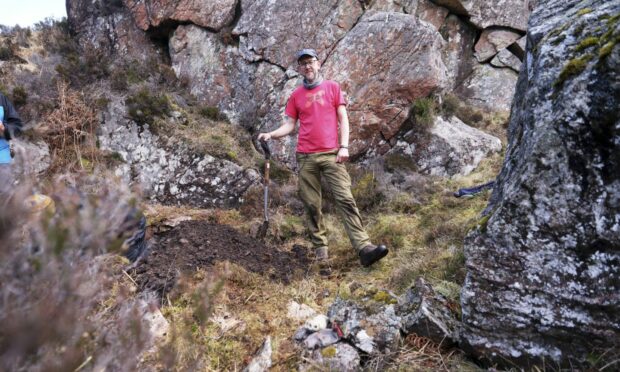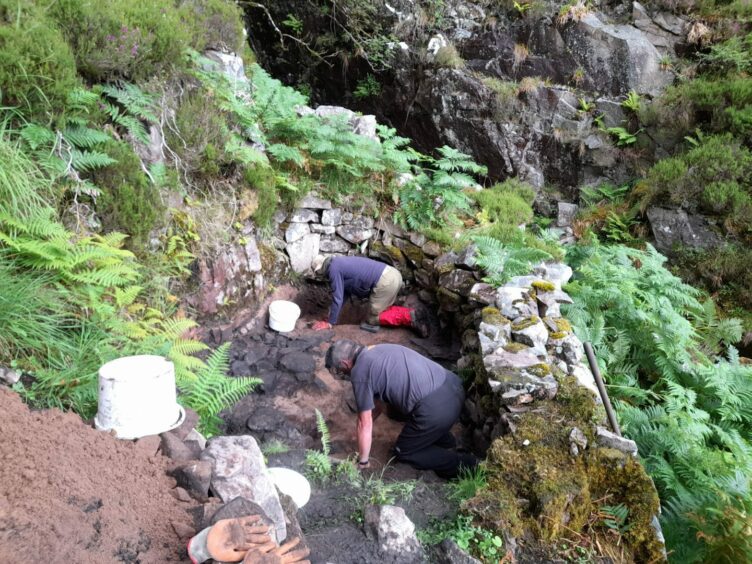Ross-shire was a hive of activity a couple of hundred years ago, not all of it legal.
Illicit stills and grain-drying kilns dotted the hillsides, cunningly concealed and jealously guarded.
In pursuit of whisky-makers determined to avoid crippling Government taxation came the inevitable excisemen, tasked with tracking down and destroying the illegal production of the water of life.
The dangerous cat and mouse game played out on both sides was never clearer to archaeologist Dr Daniel Rhodes of the National Trust for Scotland (NTS) than when he and his intrepid team clambered up a steep hillside to excavate a small bothy on a cliff edge next to a waterfall at All Tuill Bhain, Torridon at the start of August.
NTS has at least 17 illicit whisky bothies on its properties and its team of archaeologists is excavating some of them under its Pioneering Spirit project.
They’re benefitting from intelligence provided by detailed newspaper reports from the 18th century up to the 1880s, when excisemen were capturing contraband and finding equipment and still sites.
Finding illicit stills
Daniel says there was a kind of romanticism attached to the subject, with reports capturing the imagination of the UK-wide press.
Despite the dramas mainly happening in the latter part of the 19th century, local memories remain vivid.
Daniel said: “We knew about at least 17 of these sites, and as we were chatting with local people and the estate team at Torridon, they came to us with another one of these sites that hadn’t been reported before, at Allt Tuill Bhain.”
Earlier this month, the team completed a dig on the steep, rocky site, also discovering halfway up the hill the remains of a corn-drying kiln.
The kiln was a complete give-away.
Daniel said: “It’s an amazing combination of archaeological remains. There’s no good reason for a corn-drying kiln to be so far up the hill unless you’re trying to hide what you’re drying there, so the thinking is that this is almost an entire processing site.
“You could take your grain up the hill, you could soak it up the hill, it just needs to get wet so that it begins to malt, and then you stop that process happening by putting it into the corn-drying kiln and drying it there.
“Then you can grind it just using a hand-quern and then you’re right there on site at where the bothy is to make your whisky as well.”
For the archaeologists it’s not clear yet where the barley came from, whether it was from the crofts below or even bought in, but the research of local man Murdoch MacDonald has helped.

Murdoch has written The Battle of the Black Pot, an eye-opening book on illicit distillation in Torridon.
He quotes from the Manchester Times of Boxing Day 1848 describing how local children formed a train nearly a quarter of a mile long to carry a firlot, or 35lb of barley each on their shoulders, 1,000ft up the steep hillside, with a glass of whisky as a reward on their return.
Excisemen must have been easily spotted by the smugglers from their high viewpoint at Allt Tuill Bhain, as there hasn’t been much left for the archaeologists to unearth.
That’s where science can help.
Daniel said: “We’ve taken soil samples from the corn drying kiln and we’re hoping that within those soil samples we’ll be able to find evidence of not only of the fuel that was being used for the kiln but also the grain being used for malting.
“The soil has gone to conservationists AOC Archaeology Group in big bulk samples.
“They’ll do a process called wet-sieving, running it through different grades of sieve, cleaning it off and then looking under a microscope to see what’s preserved in it.
Hoping for carbonised grains
“We’ve got high hopes because the grain will survive if it’s burnt, so we’re hoping that at some point maybe the corn-drying kiln was accidentally set on fire, because that means the grain would carbonise and hopefully survive in the soil to give us the evidence of what grains they were using.”
Allt Tuill Bhain is the second still site NTS has excavated in the area.
Daniel said: “We excavated one last year called Lagaidh Dhuibh, a site we knew about from an account in The Scotsman from 1884 which gives a description of that illicit whisky still being discovered and all the equipment inside being taken out and destroyed.
“We had a really good description of where that was located, so we followed the newspaper description and worked through that process of sampling the soils and trying to find evidence of what was being used as grain to make the whisky, and as fuel for the kiln as well.”
The results are still to come back, but the archaeologists also found telling fragments of bottles and vessels preserved at Lagaidh Dhuibh.
The Allt Tuill Bhain dig yielded no artifacts, to the archaeologists’ surprise.
Daniel said: “We’re thinking that there were so many of these illicit whisky bothy sites at Torridon that actually they may be using a few of them in rotation, so they’re not leaving very much behind.
“Anything left behind can be a clue to the exciseman.”
The community was always on the alert for an unwelcome incursion by government officials.
Trumpeting the alarm
The excisemen would approach Torridon’s shores by boat and if they were spotted, the warnings weren’t subtle.
“The population would blatantly blow a trumpet,” Daniel said.
The excisemen would come ashore to find the population innocently busy in their fields, but often giving each other shifty and anxious looks, it was reported.
Sometimes the government would win, but very often it was the crofters who managed to spirit their spirits to safety by whatever means.
That might involve a three day hospitality schmooze with the exciseman who would be sent on his merry way full of good cheer and devoid of any evidence; at other times it was a much more threatening encounter.
Black arts invoked
Witchcraft and the ‘Black Art’ was even invoked, as The Scotsman of May 1884 reported, after one particular individual had made himself an object of loathing having uncovered an ingeniously secreted worm, or copper distilling pipe.
‘The means adopted in order to compass the death of this official was the well-known corp creadh, or clay image, the efficacy of which, when properly gone about, to destroy life is still implicitly believed by the bulk of people in the more remote parts of the Highlands,’ the newspaper reported.
More like this:
From illicit to licit: archaeologists reveal how world famous Speyside whisky became legal
Was a secret chamber found under Aberdeen city centre street an illicit whisky still?
Archaeologists work to uncover history of Scotland’s whisky production





Conversation